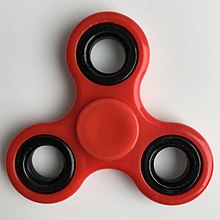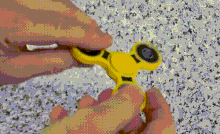 A typical three-lobed fidget spinner A typical three-lobed fidget spinner | |
| Type | Stress-relieving toy |
|---|---|
| Inventor(s) | Scott McCoskery |
| Country | USA |
| Availability | 2014–present |
| Materials | Brass, stainless steel, titanium, copper, plastic, etc. |

A fidget spinner or hand spinner is a toy that consists of a ball bearing in the center of a multi-lobed (typically three-lobed) flat structure made from metal or plastic with metal weights in the lobes, designed to spin around its central axis. Fidget spinners became very prevalent trending toys in 2017.
The toy has been promoted as helping people who have trouble focusing or those who may need to fidget to relieve nervous energy, anxiety, or psychological stress. There are claims that a fidget spinner can help calm down people who have neuro-developmental or mental disorders, such as attention deficit hyperactivity disorder and autism, though peer-reviewed studies for this notion are lacking.
A fidget spinner consists of a round, flat central bearing (usually a ball bearing) that allows the arms connected to it to rotate; around this central axis, there are usually three weighted arms, but their number varies depending on the model. When spun forcefully, they can continue spinning for up to several minutes, depending on the model.
Development
In an interview appearing on May 4, 2017, on NPR, Scott McCoskery described how he created a metal spinning device called a "Torqbar" around 2014 to satisfy with his own tendency to fidget in meetings and on conference calls while working in the information technology field in the Seattle, Washington, area of the United States. He said he believed it was the first fidget spinner as they became known in their popular form. In response to requests from an online community, he began selling the device online.
Popularity and usage

With the rapid increase in the popularity of fidget spinners in 2017, many children and teenagers began using them in school, and some schools also reported that students were trading and selling the spinner toys. The popularity of the spinners also led to them being the subject of Internet memes, particularly on 4chan and Reddit.
As a result of their frequent use by children at school, many school districts in the U.S. prohibited the toy. Some teachers argued that the spinners distracted students from their schoolwork. According to a survey conducted by Alexi Roy and published in May 2017, 32% of the largest 200 American public and private high schools had banned spinners on campus.
When fidget spinners rose in popularity in 2017, many publications in the popular press discussed the marketing claims made about them for people with ADHD, autism, or anxiety. However, there has not been research proving this notion. They quickly fell in popularity and sales after peaking in May 2017.
Invention and patent status
On May 11, 2016, Michael Scott McCoskery filed a provisional patent application for a utility patent on a version of the toy featuring a centrally mounted ball bearing and other specific design elements. His application included illustrations depicting two- and three-lobed versions of the toy. Following the submission of a final patent application in May 2017, McCoskery was granted a U.S. patent in March 2018.
On November 29, 2016, David Allen Pavelsky of Killeen, Texas, applied for a design patent covering a three-lobed version of the toy with a centrally mounted ball bearing. Unlike McCoskery's patent, Pavelsky's application did not claim functional innovation, but rather focused on the toy's aesthetic design. He was granted a design patent in October 2017.
By May 2017, the patent for fidget spinners had not yet been granted, despite growing market demand. Catherine Hettinger, a chemical engineer, was incorrectly credited by some media outlets as the inventor of the fidget spinner, with reports from publications such as Money, The Guardian, The New York Times, and the New York Post.
Hettinger had filed a patent application for a "spinning toy" in May 1993. Her invention more closely resembled some sort of "finger frisbee" or a "finger hat". The patent was issued to her in January 1997. However, she allowed the patent to lapse in 2005 after failing to find a commercial partner to manufacture the toy. Even if her patent had not lapsed, it would have expired in January 2014, prior to the rise in popularity of fidget spinners. Additionally, a May 2017 Bloomberg News article clarified that Hettinger had not invented the modern fidget spinner, as her design lacked the central bearing that allows the toy to be held and spun in place—an essential feature of today’s spinners.
See also
- Fidget Cube
- Office toy
- Stress ball
- Top
- Worry stone
- Pet Rock
- Pop it, a 2021 fidget toy
References
- McGri, David (2017-08-18). "Fidget Spinners". Huffington Post. Retrieved 2017-08-21.
- Andersen, Rachel (9 March 2022). "Experts' Advice: Fidget Spinners Are Not for ADHD Treatment". Autism Parenting Magazine.
- ^ Calfas, Jennifer (May 11, 2017). "Do Fidget Spinners Really Help With ADHD? Nope, Experts Say". Money.com. Archived from the original on March 7, 2022. Retrieved May 16, 2017.
- ^ Singh, Anita; Horton, Helena; Fuller, George (May 3, 2017). "Fidget spinners: the new classroom craze being banned across the nation". The Telegraph. Retrieved May 16, 2017.
- Anne Demoulin, « Le Hand Spinner, la toupie qui fait tourner la tête des petits et grands », 20 minutes.fr, 11 mai 2017.
- ^ Gonzalez, Guadalupe (June 8, 2017). "The Inside Story Behind the Rapid Rise of the Fidget Spinner Trend". Inc. Retrieved April 16, 2022.
- "Millions sold: Was the original fidget spinner made in Suquamish?". The Seattle Times. May 17, 2017. Retrieved April 16, 2022.
- ^ Malone, Kenny (May 4, 2017). "Fidget Spinner Emerges As Must-Have Toy Of The Year". Planet Money. NPR. Retrieved May 18, 2017.
- ^ Calfas, Jennifer (May 4, 2017). "Here's Everything You Need To Know About Fidget Spinners". Money.com. Archived from the original on October 24, 2020. Retrieved May 6, 2017.
- "Many Schools Ban Hot Toy For Being Distraction". CBS Los Angeles. May 4, 2017. Retrieved May 6, 2017.
- "Fidget Spinners For Kids: Reports Say It's Distracting, Parents Say Not So". CBS Miami. May 2, 2017. Retrieved May 7, 2017.
- Hathaway, Jay (May 24, 2021). "The dank memes and questionable science behind fidget spinners". The Daily Dot. Retrieved November 12, 2024.
- ^ Luscombe, Richard (May 5, 2017). "As fidget spinner craze goes global, its inventor struggles to make ends meet". The Guardian. Retrieved 11 May 2017.
- ^ Williams, Alex (May 6, 2017). "How Fidget Spinners Became a Hula-Hoop for Generation Z". The New York Times. Archived from the original on 20 January 2023.
- Roy, Alexi (May 10, 2017). "The Fidget Spinners Are Banned in 32% of the Largest High Schools U.S." Spinner List. Archived from the original on September 15, 2017. Retrieved June 5, 2017.
- Bogost, Ian (May 12, 2017). "The Fidget Spinner Explains the World". The Atlantic. Retrieved 2017-07-09.
- Fu, Lisa (June 14, 2017). "Get Over It. Fidget Spinner Trend Is Dead". Fortune. Retrieved September 1, 2020.
- Malone, Kenny (May 4, 2017). "Fidget Spinner Emerges As Must-Have Toy Of The Year". Planet Money. NPR. Retrieved May 18, 2017.
- US 9914063B1, Michael Scott McCoskery, "Toy designed to spin in a user's hand", issued 2018-03-13
- US D801440S1, David Allen Pavelsky, "Triple ended spinner toy", issued 2017-10-31
- ^ Brustein, Joshua (May 11, 2017). "How the Fidget Spinner Origin Story Spun Out of Control". Bloomberg News. Retrieved May 12, 2017.
- Calfas, Jennifer (May 3, 2017). "Meet the Woman Who Invented Fidget Spinners, the Newest Toy Craze Sweeping America". Money. Archived from the original on April 16, 2021. Retrieved August 31, 2018.
- Miller, Joshua Rhett (May 5, 2017). "Woman who invented fidget spinners isn't getting squat". New York Post.
- ^ US 5591062A, Catherine A. Hettinger, "Spinning toy", published 1997-01-07, issued 1997-01-07
External links
 Media related to Fidget spinners at Wikimedia Commons
Media related to Fidget spinners at Wikimedia Commons The dictionary definition of fidget spinner at Wiktionary
The dictionary definition of fidget spinner at Wiktionary